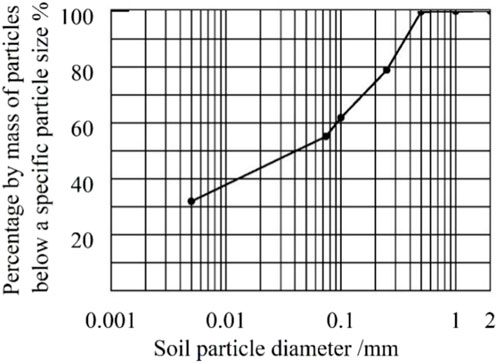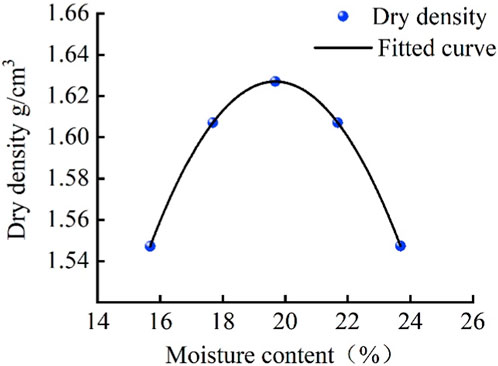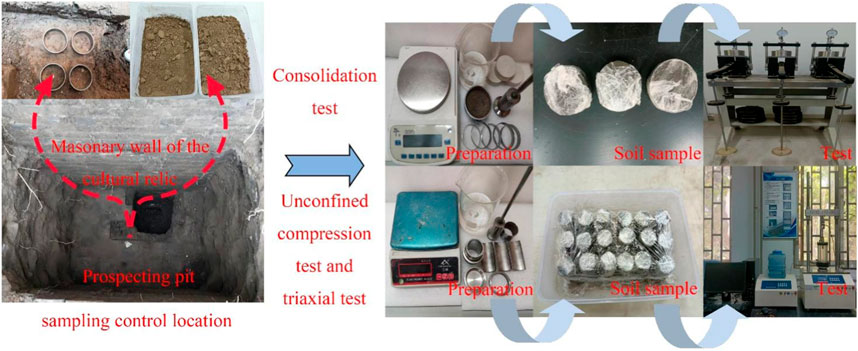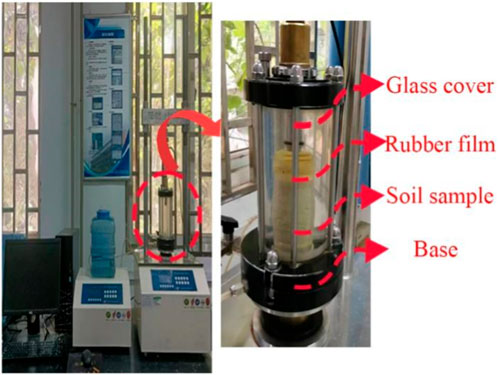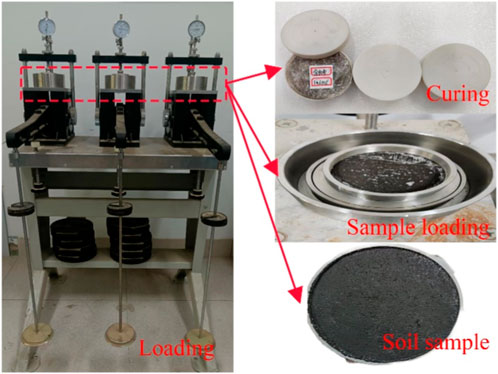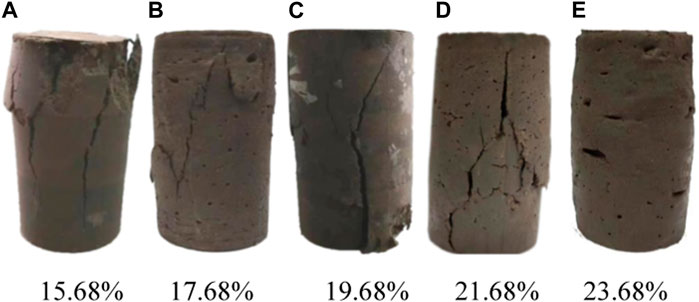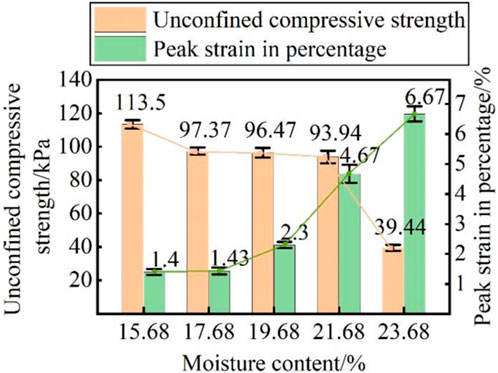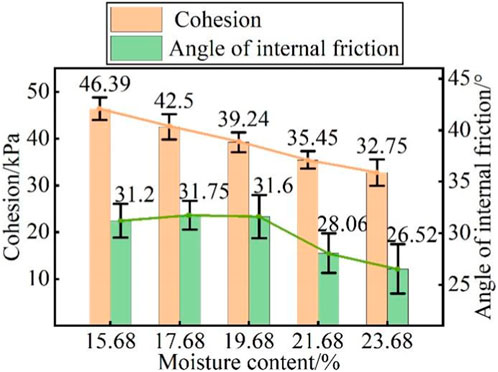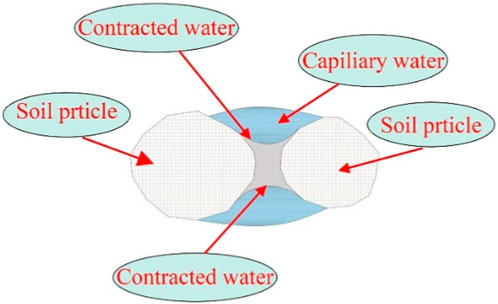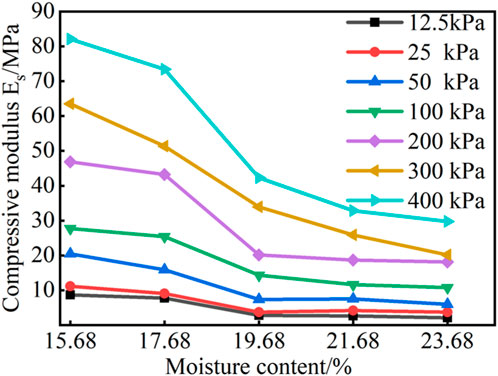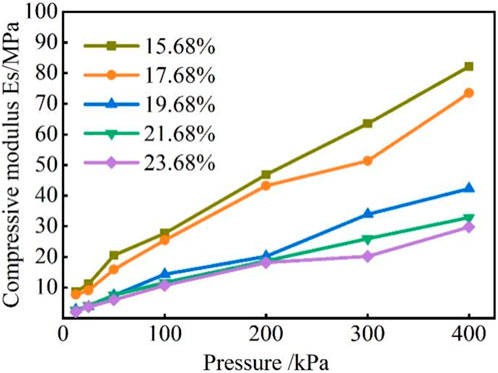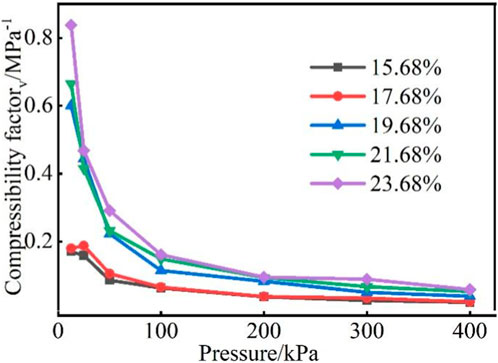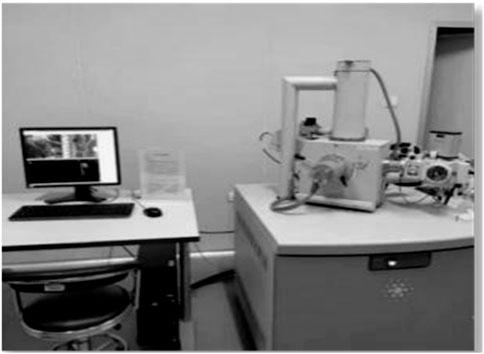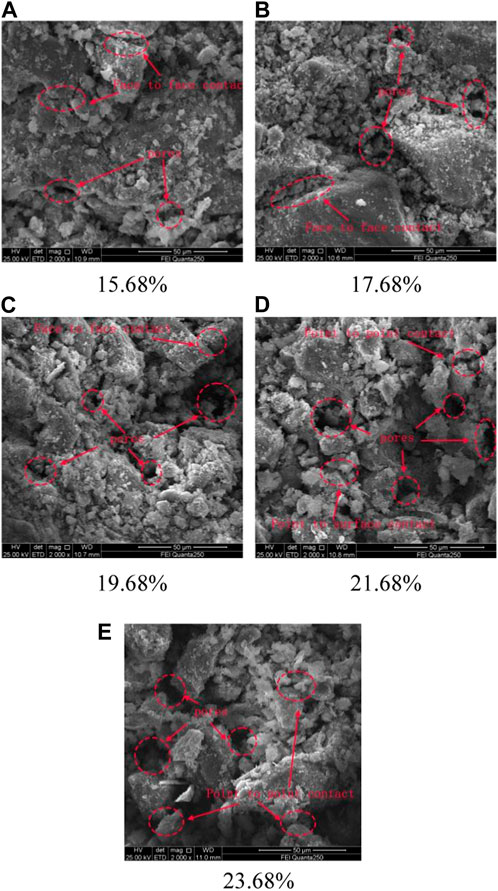- 1Kaifeng Research Center for Engineering Repair and Material Recycle, School of Civil Engineering and Architecture, Henan University, Kaifeng, China
- 2Yellow River Laboratory, Zhengzhou University, Zhengzhou, China
- 3School of Civil Engineering, Sun Yat-Sen University, Guangzhou, China
This study investigated the effects of soil moisture content on the strength and deformation properties of the foundation soils of cultural relics. Our goal is to inform the formulation and implementation of the repair scheme for cultural relics above the foundation soils and help protect cultural relics. Soil samples with five different moisture contents were prepared and used in unconfined compression, triaxial, and consolidation tests. Several mechanical parameters were determined under different soil moisture contents: failure morphology, compressive strength, compressive modulus, and compressibility coefficient. Based on the test results, the soil cohesion and angle of internal friction were obtained using Mohr’s circle. Regions where the mechanical parameters were particularly sensitive to moisture content were located during the consolidation test. These were also the regions where the soil’s compressive modulus declined rapidly, which was detrimental to the overall stability and safety of overlying structures. The internal structure and particle size distribution of the foundation soils supporting cultural relics were determined by scanning electron microscopy. Constitutive parameters of soils were determined by the triaxial test and consolidation test. It was also found that when the soil moisture content exceeded the optimal level, the foundation soils were very likely to pose a risk to the safety of the overlying cultural relics. The moisture content of foundation soils supporting cultural relics deserves special attention in engineering practice.
1 Introduction
Foundation soils serve as the cornerstone for the long-term stability of cultural relics on the soils. However, the material properties of cultural relics deteriorate under natural conditions, reducing their stability. Cultural relics are subjected to constant external environmental impacts, such as rain wash and wetting-drying/freezing-thawing cycles. As a result, spelling, chalking, cracking, and foundation subsidence may occur for the cultural relics. Prolonged or heavy rainfalls can abruptly change soil moisture content. As soil stress states change significantly, the soil strength and structure are altered accordingly. All these impacts induce structural hazards to foundation soils or cultural relics on the soils. For example, uneven foundation subsidence, column inclination, and walls tilting outwards, or even collapse will cause damage to cultural relics, incurring economic loss or casualties. Kaifeng is referred to as the Northern Water City and once served as the capital of eight dynasties in Ancient China and has rich historical and cultural legacies. However, the cultural relics in Kaifeng have been damaged to varying degrees due to perennial water corrosion. Foundation soils of cultural relics are usually modified soils and are mostly transported from distant regions. These soils may differ greatly from the local soils. There has been a growing emphasis on cultural relics protection throughout China. It is urgent to deepen our understanding about the influence of soil moisture content on the properties of foundation soils of cultural relics to support cultural relics protection.
Important findings have been made concerning some engineering problems related to soil moisture content. Unconfined compressive strength of the soil is influenced by several factors, such as moisture content and cracks. (Shimbo et al., 2022) performed unconfined compression tests on clay and found that the unconfined compressive strength was smaller at longer initial cracks and higher moisture content. The deformation modulus was related to the moisture content but independent of initial cracks. (Dutta and Yadav, 2022) found that the unconfined compressive strength of expansive soils increased with the addition of gypsum and an increase in moisture content and curing time. (Ackah et al., 2022) determined the degree of how moisture content, lime content, and dry density of silty clay affected the unconfined compressive strength. The results showed that the lime content had the greatest impact. Based on the unconfined compressive strength test of four-layer soils collected from the collapsed walls in the hilly granite area of South China, (Wang et al., 2022) found that the unconfined compressive strength first increased and then decreased as the soil moisture content increased. The cohesion of red clay and purple soil in western Sichuan and purple soil in Southwest China first increased and then increased as the moisture content increased. The shear strength and cohesion of purple soil in western Sichuan peaked when the moisture content was 15%. For purple soils in Southwest China, the cohesion peaked when the moisture content was 12% (Mao et al., 2021; Xue et al., 2022; Zeng et al., 2022). (Yin et al., 2021) conducted a consolidated-undrained triaxial compression test on clay soils from Lianyungang. They found that as the soil moisture content increased, the effective cohesion, angle of internal friction, and shear strength decreased. (Sun et al., 2022) studied the shear strength of compacted bentonite and found that soil moisture content affected the shear strength of bentonite during aging, with a lower value occurring at a moisture content of 24%. (Bouri et al., 2020) conducted direct shear tests on sandy soils with varying densities and reported that moisture content significantly affected shear strength. In addition, the cohesion and the angle of internal friction decreased as the moisture content increased. (Yilmazoglu and Ozocak, 2023) derived a formula to calculate the ultimate bearing capacity of shallow foundations (new unsaturated silt-sand soils) through direct shear tests on different unsaturated silty soils. (Uyeturk and Huvaj, 2021) performed direct shear tests on compacted residual soils and found that soil shear strength increased as soil saturation decreased. (Gong et al., 2022) analyzed the shear strength of three clay soils and showed that the soil cohesion decreased as the moisture content and saturation increased, with the highest decreasing rate in silt and the lowest in clay. The decreasing rate of the angle of internal friction was the highest in clay and the lowest in silt. Niu (Niu et al., 2021) conducted consolidation tests on Yili Loess and found that the compressive yield stress gradually decreased as the moisture content increased and the dry density decreased. The compressibility coefficient a1-2 increased continuously, while the δs-p curve showed persistently enhanced softening. (Zhang et al., 2023) reported that the initial moisture content and porosity were positively correlated with loess compressibility and negatively correlated with the compressive yield stress in the consolidation test on compacted loss. (Yang et al., 2015) found a considerable effect of moisture content in reshaping loess’s void ratio and secant modulus through the consolidation tests. As the moisture content increased, the soil’s void ratio changed from linear to non-linear. (Huang et al., 2019) conducted consolidation tests on river sediments and found that the initial and liquid-limit void ratios were key factors influencing compressibility. Under a constant liquid-limit void ratio, the compressibility coefficient increased as the initial moisture content increased. (Ngo et al., 2020) studied the compression characteristics of ultra-soft soils and divided the soils into two stages, namely, subsidence and consolidation. They proposed that the critical moisture content could be used to differentiate between slurries with large and small subsidence. (Zhang et al., 2021b) studied the influence of adsorbed water content and density on the properties of fine-grained soils. They found that the desorption temperature of adsorbed water contributed to maintaining the low compression of the fine-grained soil with high moisture content.
Among various studies on soil microstructure, (Cheng et al., 2020) were concerned with the microscopic pore structure of compacted, diluted clay. It was found that as the clay moisture content increased, the soil changed from aggregate to dispersoid. As a result, the soil particle size distribution curve changed from bimodal to unimodal shape. (Chen et al., 2021) carried out an experimental study on the effect of moisture content in reshaping the soil samples’ shear strength and microstructure. They reported a good correlation between morphological parameters of the soil structure element and the soil’s shear strength. A decrease in shear strength induced by moisture content was a macroscopic manifestation of the resulting changes in the structure element of dispersive soil.
Existing studies on soil properties are mainly conducted on undisturbed natural soils. However, the foundation soils of cultural relics are mostly disturbed soils and have been rarely studied. Relevant investigations have shown that a changing moisture content is indeed a main factor influencing the soil’s compressive strength and stability. Given the above, the impact of soil moisture content on structures cannot be neglected in engineering practice (Lu et al., 2017; Zhang et al., 2021a).
Although the influence of soil moisture content on soil strength properties has been described, the test soils were generally water-saturated and subjected to direct shear tests. In addition, the soils were artificially prepared to mimic the foundation soils of cultural relics or collected from the surrounding unprotected areas. In this study, the soil samples were from the foundation soils of a cultural relic currently under repair in Kaifeng. The soils were grayish brown, mixed with brick chips and lime, and had a larger viscosity, compared with the surrounding shallow soils. The latter is predominantly silty soils resulting from the alluvial sedimentation of the Yellow River, which are earthy yellow and higher in the content of fine sand but lower in viscosity. In this study, we carried out unconfined compressive strength test, triaxial compression test, and consolidation test to analyze the influencing law of soil moisture content on the strength and deformation properties of foundation soils of cultural relics. The research findings will provide a reference for cultural relics protection and consolidation in drought and flood seasons, thus reducing improper repair of cultural relics.
2 Materials and methods
2.1 Basic physical properties of foundation soils
The test soils were sampled from the foundation soils of a cultural relic in Kaifeng at a depth of 1.5–2.0 m. The soil samples were greyish brown and mixed with several brick chips and lime. The physical and mechanical parameters of the foundation soils were obtained by specific gravity tests and limit water content test according to the Standard for Soil Test Method (Planning press, 2019). The results are shown in Table 1. The results of soil particle size analysis are shown in Table 2, and the particle size gradation is shown Figure 1.
2.2 Test design and sample preparation
Different levels of moisture content were set up by giving consideration to real-world scenarios and potential changes in the future. Potential influence of sample dimension and preparation on test results was also considered. According to the compaction test, the optimal moisture content and the maximum dry density were 19.68% and 1.63 g/cm3, respectively (Figure 2). The optimal moisture content was defined as the mid-value, and the lower and upper bounds of the moisture content range were mid-value plus ±2% and ±4%, respectively. Hence, five moisture contents were selected for tests: 15.68%, 17.68%, 19.68%, 21.68%, and 23.68%. Three parallel tests were performed under each moisture content to reduce errors.
The purpose of the test was to identify the law of influence of soil moisture content on the strength and deformation properties of foundation soils of cultural relics. According to the compaction test, the optimal moisture content and the maximum dry density were 19.68% and 1.63 g/cm3, respectively (see Figure 2). The optimal moisture content was taken as the mid-value, and the lower and upper bounds of the range were mid-value plus ±2% and ±4%, respectively. Hence, the five moisture contents considered for tests were 15.68%, 17.68%, 19.68%, 21.68%, and 23.68%. Three parallel tests were performed for each moisture content to reduce errors.
The foundation soil samples were dried and crushed: the samples were dried at 105°C for 24 h; then, the soils were passed through a 2 mm sieve for subsequent tests. The amount of water added was estimated according to the specifications and the test protocol. The distilled water was weighed accordingly, sprayed onto the soil samples stepwise and mixed. Then, the soil samples were sealed in preservation bags and left to stand for 24 h. Measures were taken to ensure that the soil moisture content was uniformly distributed. Next, the moisture content of the soil samples was re-tested to confirm that it met the requirements. The maximum error of the moisture content was controlled at ±1%.
The soil samples had a dimension of 39.1 × 80 mm (diameter × height) for the unconfined compression test and the triaxial test and 61.8 × 20.0 mm (diameter × height) for the consolidation test. The soil samples were compacted in three layers to ensure the same degree of compaction. The soils were compacted 25 times for each layer. It should be noted that the contact surfaces between the soil layers were roughened with a scalpel to ensure tight bonding. The test flow chart is shown in Figure 3.
2.3 Test equipment and instruments
The influence of moisture content on the soil’s mechanical properties was analyzed. For this purpose, unconfined compression and triaxial tests were conducted using the TSZ-10 automatic triaxial tester, which determined unconfirmed compressive strength and shear strength of the soil samples. The test apparatus is shown in Figure 4. The peak axial stress reading plus 3% of the axial strain would be the test value of the unconfined compressive strength of the soil. The shear rate was 0.8 mm/min, and the sampling step size was 0.20 mm. Based on site conditions and burial depths of the foundations, three confining pressures were specified for the triaxial test, namely, 50, 100 and 150 kPa. When the peak value of the curve was significant, this peak value was directly used as the principal stress difference; otherwise, the axial stress corresponding to 15% of the axial strain was taken.
WG single lever consolidation instrument was used for consolidation tests under different moisture contents, as shown in Figure 5. Eight normal load levels were applied to the soil samples: 12.5, 25, 50, 100, 200, 300, 400, and 800 kPa. The reading was recorded separately for each normal load level. The variation within each hour should be maintained below 0.01 mm, the prerequisite for moving to the next normal load level. Test data were recorded for each normal load level after stabilizing the values.
3 Analysis of the influence of moisture content on soil strength
3.1 Unconfined compressive strength analysis
Unconfined compressive strength test is a common test to evaluate soil strength in geotechnical engineering. In this section, the influence of moisture content on soil samples was studied by characterizing the failure morphology and compressive strength.
3.1.1 Influence of moisture content on failure morphology
Figure 6 shows that the samples’ failure morphology varied with the soil moisture content. Crushing failure occurred at a lower moisture content. The top of the samples was more severely damaged. On the lateral surfaces, several oblique cracks appeared, with an inclination angle of about 60°. The shear plane was severely damaged. The connection induced by water molecules forming a thin film between the soil particles was relatively low at a low moisture content, and the soil particles were loosely connected. As the moisture content increased, a principal shear plane was gradually formed on the sample surface. The cracks penetrated the samples from top to bottom. At the maximum moisture content, there were more pores on the sample surface, and bulging failure happened. As the pores were squeezed by soil particles, compression and bulging deformation occurred. As the moisture content continued to increase, there was a transition from shear failure to bulging failure. This law of failure agreed with that observed by Zhao (Zhao et al., 2015) in the triaxial test of red clay. This is mainly because the changes in moisture content altered the pore state within the soil samples.
3.1.2 Influence of moisture content on unconfined compressive strength
The curves of unconfined compressive strength or peak strain vs. moisture content in Figure 7 indicated an overall decreasing trend of the compressive strength of soil samples as the moisture content increased. The compressive strength was relatively stable at a moisture content between 17.68% and 21.68%. When the moisture content ≥21.68%, the compressive strength decreased more rapidly. Meanwhile, the peak strain showed an increasing trend. However, beyond the optimal moisture content, the strain rose even more rapidly. As the moisture content increased from 15.68% to 17.68%, the unconfined compressive strength decreased by 16.13 kPa (14.21%), while the peak strain increased by 0.04%. As the moisture content increased from 17.68% to 19.68%, the compressive strength did not decrease significantly (0.92%), while the peak strain increased by 1.04%. As the moisture content increased from 19.68% to 21.68%, the compressive strength decreased by 2.62%, while the peak strain increased by 2.84%. Thus, the sample underwent plastic failure. As the moisture content further increased, the compressive strength of the soil samples decreased rapidly by 58.02%, while the peak strain increased by 2.40%. (Yilmaz et al., 2019) obtained similar results from their study on the influence of moisture content on soils’ compressive strength. That is, the moisture content had a larger impact on the soils’ compressive strength. The compressive strength decreased considerably when the moisture content exceeded the optimal level. We can infer that as the moisture content increased, the soil particles formed aggregates instead of being loose, which increased the cohesion between the particles. Interparticle cementation gradually gave way to shear resistance. By contrast, the interparticle cementation was weaker at a low moisture content, and the shear resistance could hardly counteract the effects of loading that would cause damage within the samples. In that case, a failure already occurred in the samples, even at a small axial strain. The samples underwent lateral deformation under unconfined compressive loading. Tiny cracks began to appear in the soil masses. The shear plane was formed as the cracks kept propagating. Increasing the moisture content could increase soil cementation and shear resistance to a certain degree. Therefore, the damage to the soil was weakened, and the soils’ plastic deformation was increased, thus delaying the failure. In engineering practice. Comparing the compressive strength between undisturbed and disturbed soils can facilitate soil sensitivity assessment.
3.2 Shear strength analysis
Consolidated-undrained triaxial compression test (UU) was performed. Shear strength
The principal stresses σ1 and σ3 were obtained for the soil samples through the tests. The cohesion and the angle of internal friction were also obtained, as shown in Figure 8. As the moisture content increased, the cohesion decreased. Near the optimal moisture content, the angle of internal friction first remained stable and then decreased rapidly. At a moisture content of 15.68%, the cohesion and angle of internal friction were 46.39 kPa and 31.20°, respectively. For every increase in the moisture content by 2%, the cohesion and angle of internal friction decreased by (8.39%, 7.67%, 9.66%, 7.62%), and (−1.76%, 0.47%, 11.20%, 5.49%), respectively. Thus, the moisture content had a significant impact on the cohesion and angle of internal friction. This may be because water significantly affected interparticle cementation, thus changing the cohesion. The greater the amount of bound water, the larger the interparticle distance, and the smaller the angle of internal friction would be. As a result, the interparticle cementation and cohesion were weakened. (Huang et al., 2012) Found that for remolded soil, the cohesion decreased as the moisture content increased. We observed a similar variation pattern, except that the cohesion decreased at a steadier rate and the angle of internal friction changed in a different way. The differentiation in the soils’ mechanical properties might be attributed to the differences in the sensitivity of varying mineral components of the soils to water.
The soil structure and original soil cementation were disrupted during remodeling (Tang et al., 2022). The interparticle cementation distribution is shown in Figure 9. The main oxides in the soil were in an unbound state. A few oxides were adsorbed onto the soil surface as single crystals or aggregates. The cohesion decreased as the soil aggregates were weakened. Water is present in the soil in two states, i.e., bound and free (capillary water). When there is bound water within the soil, the particles bond to each other. The interparticle cementation serves as the shear resistance in the soil. Some soil particles are crushed under the external force during the remodeling process, resulting in more fine particles. Soil particles form aggregates through bound water and may function as “coarse-grained” particles to a certain degree, resulting in an alteration of soil particle gradation. In the meantime, the interparticle pores are enlarged, and the interparticle forces become smaller. A high moisture content can cause the bound water film between the soil particles to thicken, accompanied by reduced cohesion. In the test, the amount of free water in the soil was smaller before the optimal moisture content was reached. The soil particles were interlinked and lapped, and the sliding surfaces were relatively rough. Frictional resistance mainly resulted from friction between the soil particles. As the moisture content increased, the bound water film became thicker, and the effective interparticle distance increased. Soil particles were more likely to slip and dislocate under external forces. Thus, the main resistance changed from interparticle friction to Van der Waals force in the bound water film, reducing cohesion and angle of internal friction (Hu et al., 2015).
4 Analysis of the influence of moisture content on soil’s compressive modulus
Several factors have been identified to influence the subsidence of foundation soils, and soil moisture content is believed to exert a greater impact. Consolidation test is an important method to obtain the soil’s compressive deformation parameters. Based on the consolidation test and the relationship between the subsidence, compressive modulus and compressibility coefficient, we estimated the subsidence of soil samples for each load level (Eqs 1–3). The curves were plotted after data processing, and the law of influence of moisture content on soil deformation properties was revealed.
where
A comparative analysis in Figure 10 revealed that at a constant normal load, the compressive modulus decreased as the moisture content increased. Moreover, the compressive modulus decreased more rapidly under the load of 200–400 kPa before reaching the optimal moisture content. The soil parameters were particularly sensitive to changes in moisture content ranging between 15.68% and 19.68%. Beyond that, the moisture content slightly affected the compressive strength.
As shown in Figure 11, the compressive modulus of the soil increased with the consolidation pressure. As the consolidation load increased from 200 kPa to 400 kPa, the compressive strength increased more rapidly. The compressive strength of the soil was smaller at a high moisture content (19.68%–23.68%) than at a low moisture content (15.68%–17.68%). As the load increased, the soil compressibility decreased. This is because at a low consolidation pressure, the soil pores were compressed, releasing the air from the inside. Therefore, the soil volume decreased significantly, and the soil had a higher compressibility. A higher moisture content caused the bound water film within the soil particles to thicken. As the amount of free water increased, soil cementation was weakened, resulting in a larger number of pores in the soil. The soil pores were compressed and closed under the combined action of high moisture content and high consolidation pressure. Therefore, a portion of free water was confined within the pores, filling the pores. As the loading continued, the free water in the soil escaped via the capillary channels, increasing soil compressibility compared with the value at a low moisture content. This phenomenon agreed with the observation by (Xiong et al., 2015), who reported a positive correlation between the compressive modulus and pressure.
The compressibility coefficient is commonly used to assess the compression performance of foundation soils of cultural relics. Its value is related to the variation range of pressure
Figure 12 shows the curves of pressure vs. compressibility coefficient of the soil samples under different moisture contents. The slope of the curves reflects the soil compressibility. As the pressure increased from 12.5 kPa to 200 kPa, the compressibility coefficient decreased significantly. The higher the moisture content, the more sensitive the compressibility coefficient. The moisture content had a larger impact on the soil’s compressibility coefficient. Soil masses with a higher moisture content were more likely to be compressed, while those with a lower moisture content were not easily compressed. As the load exceeded 200 kPa, the compressibility coefficient approached a constant. The variation pattern of compressibility coefficient observed in this study was consistent with that in Huang (Huang et al., 2019). The initial moisture content of soils was closely related to the compressibility coefficient and the two were positively correlated.
The compressibility coefficient corresponding to the moisture content of 15.68%, 17.68%, 19.68%, 21.68%, and 23.68% was 0.06, 0.07, 0.11, 0.15, and 0.16 MPa−1, respectively. According to the Code for Design of Building Foundation (Planning Press, 2012), soil with a moisture content between 15.68% and 17.68% is defined as low compressibility soil; soil with a moisture between 19.68% and 23.68% is defined as medium compressibility soil. If the remolded soil has a low moisture content, there are more pores in the soil particles. However, since the soil particles are interlinked and lapped, they encounter more resistance to relative slip, thus impairing the compression performance. Higher moisture content increases the thickness of the bound water film, and the soil particles slip and dislocate more easily. The pores between the soil particles are compressed under the consolidation pressure, which is conducive to the compression performance of the soil. The above results prove that the moisture content changes considerably influence the compression performance of the foundation soils of cultural relics. The higher the moisture content, the greater the influence on the compression performance of the foundation soils; otherwise, the smaller the influence on the compression performance. The above findings agree with the observation about an increased soil compressibility under a higher moisture content as made by (Guo et al., 2021) We suggest that a greater importance should be attached to the influence of moisture content on soil deformation properties in the maintenance and conservation of cultural relics.
5 Microscopic tests
Soil microstructure is considered a manifestation of conditions under which the soil is formed and has an impact on soil’s engineering characteristics. Soil microstructure is interconnected with and interacts with soil structure element. Specifically, soil microstructure reflects the size and shape of soil structure elements and the mode of interparticle connection. Microscopic test is an important method for soil study. Macroscopic and microscopic soil studies at home and abroad have demonstrated that the soil’s macroscopic mechanical properties are closely related to soil particle morphology and interparticle pores.
Scanning electron microscopy (SEM) was performed in this study to compare the microstructure of foundation soils for cultural relics under different moisture contents. The test instrument is shown in Figure 13. By SEM with 2000 times magnification, we could clearly visualize the soil particle morphology and pore characteristics. The SEM images of foundation soils with different moisture contents are shown in Figure 14.
It can be observed from Figure 14A that the soil particles were well connected with each other. The dominance of soil skeleton resulted in a high density. There were fewer pores between the particles, and the pore diameter was small. The face-to-face contact of soil particles dominated. As the moisture content increased to 17.68%, the interparticle pores and porosity increased as well. Besides, the pore diameter was larger at a moisture content of 17.68% than at 15.68%. The interparticle connection was weakened, and there were more loose particles in the soil skeleton. The soil particles were loosely connected. As the moisture content increased to the optimal level, the pore structure changed significantly. The number of loose particles continued to increase. There were fewer larger particles but more smaller particles. Interparticle pores also increased considerably than at a moisture content of 17.68%, and the pore diameter also increased. When the moisture content increased to 21.98%, the pores within the soil samples further increased. The soil pore structure continued developing from a small pore size to a larger one. There was also a transition from face-to-face contact between soil particles to point-to-face contact. Capillary channels in soil became much more visible, and the soil structure was worse. When the moisture content increased to the maximum, the interparticle distance in the soil continued to increase. Voids and capillary channels were visible between the particles. Besides, the pore number and size increased, accompanied by a transition from point-to-face contact to point-to-point contact. More and larger pores appeared in the soil, and the soil structure further deteriorated.
In a word, as the moisture content increased, there were fewer larger particles and more smaller particles than at a lower moisture content. The interparticle pores became larger in size and number as the moisture content increased. Before reaching the optimal moisture content, there was a transition from face-to-fact contact to point-to-face contact of soil particles. Beyond the optimal level, the transition proceeded from point-to-face contact to point-to-point contact. Capillary channels become more visible in the soil as the moisture content increased.
The reason is that at a lower moisture content, the water film formed between particles was thinner and the soil particles were more closely lapped. The resistance to compression failure was enhanced. As the moisture content increased, the soil particles wrapped in the water film were further away from each other. Therefore, the soil particles were more loosely lapped over each other. When the moisture content was 21.68%–23.68%, the soil skeleton was filled with free and bound water, which reduced interparticle contact and made the soil loose. Moreover, a greater amount of free water caused the water film to thicken, making interparticle slip easier. Therefore, the soil sample’s strength decreased abruptly. This result agreed with the law of influence of moisture content on the strength of subgrade soil as analyzed by Khoury N using SEM (Khoury, 2019).
6 Conclusion
(1) The tests showed that the moisture content had a larger impact on the soil’s compressive strength. The higher the moisture content, the smaller the compressive strength and the higher the strain. At a smaller moisture content, the soil underwent brittle failure in the direction of 60°, with the appearance of an obvious shear plane. As the moisture content increased, bulging and plastic failure became the predominant failure modes. The ratio of the soil’s compressive strength measured after the test to the initial strength of the undisturbed soil could be used as a soil strength stability indicator to inform cultural relics repair.
(2) Soil cohesion decreased as the moisture content increased. The angle of internal friction decreased abruptly beyond the optimal moisture content, and so did the soil’s shear strength. This is mainly because due to the constantly changing status of soil bound water, soil particles slipped or dislocated. A larger moisture content was detrimental to the soil’s bearing capacity. We recommend soil moisture content as an important indicator in health and safety monitoring of cultural relics.
(3) According to the Code for Design of Building Foundation, foundation soils for cultural relics are low compressibility soils at a low moisture content and medium compressibility soils at a high moisture content. The consolidation tests showed that the soil’s compressive modulus decreased as the moisture content increased. The mechanical indicators of soil were worse at a higher moisture content, and the soil deformation was also larger. This is mainly because there is a greater amount of free water in the soil skeleton at a higher moisture content, which decreases the bonding force between the soil particles. The influence of moisture content on foundation soil subsidence of cultural relics was even more pronounced beyond the optimal moisture content.
Data availability statement
The original contributions presented in the study are included in the article/supplementary material, further inquiries can be directed to the corresponding authors.
Author contributions
SM performed the tests, analyzed the data and wrote the paper. YY, PB, and CG contributed to examination of all of the tests. All authors contributed to the article and approved the submitted version.
Acknowledgments
The authors would like to thank the financial support by the China Postdoctoral Science Foundation Funded Project (No. 2018M632805) and Key Scientific and Technological Project of Henan Province (No. 232102321066).
Conflict of interest
The authors declare that the research was conducted in the absence of any commercial or financial relationships that could be construed as a potential conflict of interest.
Publisher’s note
All claims expressed in this article are solely those of the authors and do not necessarily represent those of their affiliated organizations, or those of the publisher, the editors and the reviewers. Any product that may be evaluated in this article, or claim that may be made by its manufacturer, is not guaranteed or endorsed by the publisher.
References
Ackah, F. S., Hailiang, W., Huaiping, F., Cheng, L. C., and Feng, L. Z. (2022). Use of Taguchi method to evaluate the unconfined compressive strength of quicklime stabilized silty clayey subgrade. Case Stud. Constr. Mater. 17, e01417. doi:10.1016/j.cscm.2022.e01417
Bouri, D., Krim, A., Brahim, A., and Arab, A. (2020). Shear strength of compacted chlef sand: Effect of water content, fines content and others parameters. Studia geotechnica Mech. 42 (1), 18–35. doi:10.2478/sgem-2019-0027
Chen, J. P., Liu, J., Wang, Q., Han, Y., Wang, J. Q., and Li, X. H. (2021). Microscopic interpretation of water content influence on shear strength of dispersive Soil. J. Jilin Univ. (Earth Sci. Ed. 51 (3), 792–803. (in Chinese).
Cheng, Q., Tang, C. S., Zeng, H., Zhu, C., An, N., and Shi, B. (2020). Effects of microstructure on desiccation cracking of a compacted soil. Eng. Geol. 265 (C), 105418. doi:10.1016/j.enggeo.2019.105418
Dutta, R. K., and Yadav, J. S. (2022). Reply to the discussion: The impact of variation of gypsum and water content on the engineering properties of expansive soil Transp. Infrastruct. Geotechnol. 9, 130. doi:10.1007/s40515-021-00217-z
Gong, W. P., Quan, C., Li, X. X., Wang, L., and Zhao, C. (2022). Statistical analysis on the relationship between shear strength and water saturation of cohesive soils. Bull. Eng. Geol. Environ. 81 (8), 337. doi:10.1007/s10064-022-02811-y
Guo, Y. X., Ni, W. K., and Liu, H. S. (2021). Effects of dry density and water content on compressibility and shear strength of loess. GEOMECHANICS Eng. 24 (5), 419–430.
Hu, F. N., Xu, C. Y., Li, S., Yu, Z. H., Li, Y., and He, X. H. (2015). Particles interaction forces and their effects on soil aggregates breakdown. Soil & Tillage Res. 147, 1–9. doi:10.1016/j.still.2014.11.006
Huang, K., Wang, J. W., Chen, G., and Zeng, Y. (2012). Testing study of relationship between water content and shear strength of unsaturated soils. Rock Soil Mech. 33 (09), 2600–2604. (in Chinese).
Huang, S. H., Wang, J., Mou, C., and Ding, J. W. (2019). One-dimensional compression behavior of reconstituted river sediments with organic matter. J. Civ. Environ. Eng. 41 (05), 35–41. (in Chinese).
Khoury, N. (2019). Moisture hysteretic behavior of fine-grained soils stabilized with lime and class C fly ash. Int. J. Geomechanics 19 (9). doi:10.1061/(asce)gm.1943-5622.0001449
Lu, l., Wang, H. F., and Hu, D. W. (2017). Influence of moisture content and grain composition on shear strength of slightly dense gravel soil and bearing capacity of foundation. J. Civ. Environ. Eng. 39 (03), 138–144. (in Chinese).
Mao, H. T., Huang, H. J., Yan, X. J., and Wang, X. J. (2021). Numerical study on macroscopic and microscopic parameters of particle flow in unsaturated purple soil triaxial test. J. Eng. Geol. 29 (03), 711–723. (in Chinese).
Niu, L. S., Zhang, A. J., Wang, Y. G., Ren, W. Y., and Zhang, W. (2021). Characteristics of compressibility and collapsibility of Ili loess under varying water content and dry density. J. Journal of Hydroelectric Engineering 40 (2), 167–176. (in Chinese).
Ngo, D. H., Horpibulsuk, S., Suddeepong, A., Hoy, M., Chinkulkijniwat, A., Arulrajah, A., et al. (2020). Compressibility of ultra-soft soil in the mae moh mine, Thailand. Thail. Eng. Geol. 271, 105594. doi:10.1016/j.enggeo.2020.105594
Planning Press (2012). Code for design of building foundation: GB 50007-2011. Beijing: China Planning Press. (in Chinese).
Planning Press (2019). Standard for geotechnical testing method: GB/T 50123-2019. Beijing: China Planning Press.
Shimbo, T., Shinzo, C., Uchii, U., Itto, R., and Fukumoto, Y. (2022). Effect of water contents and initial crack lengths on mechanical properties and failure modes of pre-cracked compacted clay under uniaxial compression. Eng. Geol. 301, 106593. (prepublish). doi:10.1016/j.enggeo.2022.106593
Sun, D. A., Zhang, Q. Y., and Peng, F. (2022). Effect of aging on shear strength of compacted GMZ bentonite. Eng. Geol. 302, 106632. doi:10.1016/j.enggeo.2022.106632
Tang, L. S., Wang, H., Sun, Y. L., and Liu, Q. X. (2022). Change of tensile strength of granite residual soil during drying and wetting. Rock Soil Mech. 43 (03), 1749–1760. (in Chinese).
Uyeturk, C. E., and Huvaj, N. (2021). Constant water content direct shear testing of compacted residual soils. Bull. Eng. Geol. Environ. 80 (1), 691–703. doi:10.1007/s10064-020-01893-w
Wang, C., Li, Z. W., Cai, B., Tan, Q., Li, Y., He, L., et al. (2022). Effect of root system of the Dicranopteris dichotoma on the soil unconfined compressive strength of collapsing walls in hilly granite area of South China. CATENA 216, 106411. doi:10.1016/j.catena.2022.106411
Xiong, L. Y., Chen, W. W., Ma, Y. W., and Bi, J. (2015). Study of compression characteristic of compacted loess. Sci. Technol. Eng. 15 (09), 221–224+234.
Xue, K., Zheng, G., Li, D. S., Ma, X. H., Liu, J. P., Zheng, T., et al. (2022). Experimental study on water sensitivity of shear strength of purple soil in Western Sichuan. J. Arid Land Resour. Environ. 36 (04), 95–101. (in Chinese).
Yang, P., Wu, M. H., and Xu, D. X. (2015). Laboratory test on effect of moisture content on deformation characteristics of remolded loess. J. Eng. Geol. 23 (06), 1066–1071. (in Chinese).
Yilmaz, Y., Eun, J., Panahi, S. S., and Mousavi, M. S. (2019). Effects of height-to-diameter ratio (H/D) for specimens with various water contents on unconfined compressive strength of a clayey soil. Eng. Geol. 257, 105136. doi:10.1016/j.enggeo.2019.05.013
Yilmazoglu, M. U., and Ozocak, A. (2023). Bearing capacity of shallow foundations on unsaturated silty soils. Appl. Sci. 13 (3), 1308. doi:10.3390/app13031308
Yin, J., Zhang, K., Geng, W., Gaamom, A., and Xiao, J. (2021). Effect of initial water content on undrained shear strength of K0 consolidated clay. Soils Found. 61 (5), 1453–1463. doi:10.1016/j.sandf.2021.08.010
Zeng, Z. T., Pan, B., Wu, Y. D., Zhang, B. H., and Liang, Z. (2022). Influence mechanism of bound water on shear strength characteristics of lateritic clay. Chin. J. Undergr. Space Eng. 18 (05), 1565–1572+1579. (in Chinese).
Zhang, L., Li, T., and Zhang, Y. (2023). A simple method for predicting wetting-induced collapse behavior of compacted loess with various initial void ratios and moisture contents. Environ. Earth Sci. 82 (1), 24. doi:10.1007/s12665-022-10674-5
Zhang, Q., Yang, Z. N., Shi, W., Ling, X. Z., and Tu, Z. B. (2021a). Experiment on shear characteristics of unsaturated expansive soil with initial moisture content under freezing-thawing cycles. J. Jilin Univ. (Earth Sci. Ed. 51 (05), 1544–1550. (in Chinese).
Zhang, R., Xiao, Y. P., Wu, M. L., Zheng, J. L., and Milkos, B. C. (2021b). Measurement and engineering application of adsorbed water content in fine-grained soils. J. Central South Univ. 28 (5), 1555–1569. doi:10.1007/s11771-021-4715-9
Keywords: foundation soils, cultural relics, moisture content, strength, compressive modulus, compressibility
Citation: Ma S, Yao Y, Bao P and Guo C (2023) Effects of moisture content on strength and compression properties of foundation soils of cultural relics in areas flooded by the Yellow River. Front. Mater. 10:1186750. doi: 10.3389/fmats.2023.1186750
Received: 15 March 2023; Accepted: 01 June 2023;
Published: 15 June 2023.
Edited by:
Tadeusz Hryniewicz, Koszalin University of Technology, PolandReviewed by:
Sonia Mariel Vrech, Universidad Nacional de Tucumán, ArgentinaXiangbing Gong, Changsha University of Science and Technology, China
Copyright © 2023 Ma, Yao, Bao and Guo. This is an open-access article distributed under the terms of the Creative Commons Attribution License (CC BY). The use, distribution or reproduction in other forums is permitted, provided the original author(s) and the copyright owner(s) are credited and that the original publication in this journal is cited, in accordance with accepted academic practice. No use, distribution or reproduction is permitted which does not comply with these terms.
*Correspondence: Shaochun Ma, c2NtYUB2aXAuaGVudS5lZHUuY24=; Chengchao Guo, Z3VvY2hjaDI1QG1haWwuc3lzdS5lZHUuY24=
 Shaochun Ma
Shaochun Ma Yudi Yao1
Yudi Yao1

